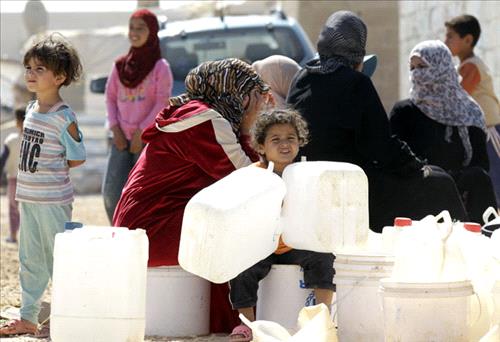Ammon News - by Hana Namrouqa/ Jordan Times
AMMAN — A study has warned that the pollution of a main aquifer lying beneath the Zaatari Refugee Camp in Mafraq Governorate is a matter of time.
The study, which was prepared by the Ministry of Water and Irrigation, indicated that over-pumping to meet the demand of hundreds of thousands of Syrian refugees is not the only risk facing the aquifer, but the fact that pollution due to wastewater leakage is expected within one to ten years.
“As a result of investigation and based on the geological characteristics of the layers topping the groundwater beneath the camp, it can be concluded that in Zaatari camp area… the pollutants are expected to reach the saturated zone, in the worst case scenario, within one year,” the study, a copy of which was made available to The Jordan Times, warned.
However, if disposal of liquid waste generated at the refugee camp was done in an organised and monitored method, pollution of the aquifer may occur after a decade.
“… Whereas, it [pollutants] may reach the saturated zone within 10 years in the most optimistic case, taking into consideration continuous disposing of liquid waste from the camp,” the study said.
However, pollution of the aquifer may happen earlier, according to the study, which said that the infiltration speed of pollutants usually increases significantly during the rainy season.
At least half-a-million Syrians have taken refuge in the Kingdom since the Syrian conflict erupted in March 2011.
Over 70 per cent of Syrian refugees in Jordan live amongst host communities, while the rest are accommodated at the Zaatari Refugee Camp in Mafraq Governorate and the Mreijeb Al Fhoud Camp in Zarqa Governorate.
The Zaatari camp currently hosts around 150,000 refugees, while Mafraq is hosting another 100,000 refugees, which is placing pressure on the local sewage network, causing it to frequently overflow, according to officials and residents of Mafraq.
The study said that a total of 34.164 million cubic metres of wastewater are generated annually by the Syrian refugees in Jordan.
Water Minister Hazem Nasser said pollution of the aquifer beneath the Zaatari camp was possible.
“Pollution can happen within four months or years if we don’t take the right and serious measures when storing and disposing of wastewater,” Nasser told The Jordan Times at a recent meeting.
The minister highlighted that if cesspits are emptied frequently and tankers transferring the wastewater out of the camp are monitored, pollution of the aquifer can be prevented.
“Some tankers were discovered dumping their load of wastewater in nearby wadis [valleys]; therefore, we have coordinated with the Public Security Department to monitor and track all wastewater tankers when transferring their load to the Ikeider Landfill,” Nasser underscored.
He noted that the ministry, in cooperation with UNICEF and the German government, plans to install mobile wastewater treatment units at the camp.
“Wastewater will be treated and used for the irrigation of certain fodder crops,” the minister noted.
